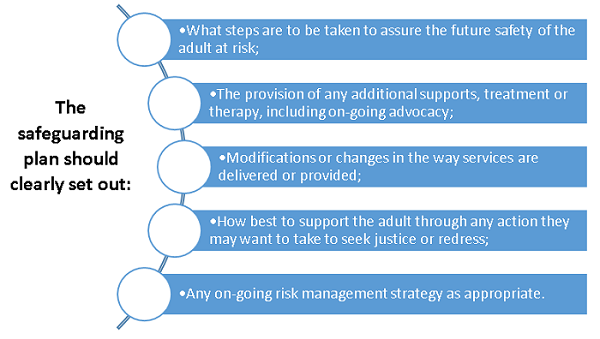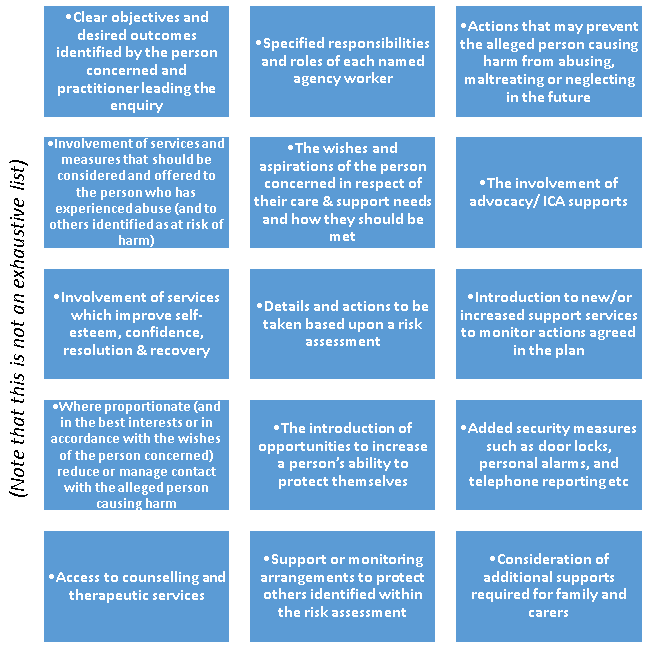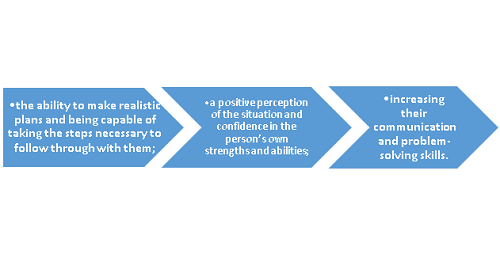The Four Stage Approach - Stage Three: Safeguarding Plan and Review
SCOPE OF THIS CHAPTER
The safeguarding plan formalises the actions required that safeguard against abuse and neglect and offers resolution and recovery. Safeguarding plans can be put into place either during an enquiry or at the end of the enquiry stage. A safeguarding plan should not be confused with a care and support plan; however, actions that may safeguard, protect or help monitor situations can form part of an ongoing care plan.
It is good practice to introduce a safeguarding plan. A safeguarding plan may not be required in all cases. A clear rationale should be recorded as to why a safeguarding plan was not made; may be linked to support planning or other unique strengths, networks and circumstances, or supports available to the individual. The safeguarding plan should be agreed and co-created with the involvement of the person at risk (or their representative). An easy read plan should be considered for clients who would benefit from pictorial information formats.1. The Safeguarding Plan

The safeguarding plan should outline the roles and responsibilities of all individuals and agencies involved and should identify the lead professional who will monitor and review the plan, and when this will happen. Adult safeguarding plans should be person-centred and outcomes-focused. Safeguarding plans should be made with the full participation of the adult at risk. In some circumstances it may be appropriate for safeguarding plans to be monitored through ongoing care management responsibilities. In other situations, a specific safeguarding review may be required.
2. Aspects that could (possibly) be Included in a Safeguarding Plan

3. Recovery and Resilience Building
Adults who have experienced abuse and neglect may need to build or rebuild their resilience.
Resilience is supported by recovery actions, which includes adults identifying actions that they would like to see to prevent the same situation arising. The process of resilience is evidenced by:
Building resilience is a process whereby people use their own strengths and abilities to overcome what has happened, learn from the experience and have an awareness that may prevent a reoccurrence, or at the least, enable people to recognise the signs and risks of abuse and neglect, and know who and how to contact for help.
Resilience processes promote well-being, protect against risk factors, benefit individuals and increase their capacity for recovery. This can be achieved through individual coping strategies assisted by:

- Stronger personal networks and communities;
- Involvement with other services, such as care management or psychological services to assist in building resilience;
- Restorative practice.
Some local resources include the Listening Lounge, Recovery College, Yes Project (under 25's) and Jersey Talking Therapies.
4. Restorative Practice
Restorative processes are facilitated encounters between people who have caused harm and those affected by that harm, which provide a structure to acknowledge the wrongdoing as well as the damage to relationships, empowering all involved to reflect on how the harm can be repaired and a positive way forward found. Developments in social work practice, such as the Making Safeguarding Personal agenda, the Care Act 2014 and a general trend towards strengths and relationship-based practice in adult social care have also encouraged an interest in restorative practice (RiPFA 2019).
N.B: restorative approaches are generally inappropriate and potentially damaging in cases of domestic violence where there is a gender control or power control element to the crime.

Restorative practices and approaches may be helpful in some safeguarding cases – especially in building bridges within families or friendship groups (where appropriate). For more information, click here.
5. Reviewing the Safeguarding Plan
The enquiry officer (in conjunction with the safeguarding coordinator) should monitor the plan on an on-going basis, within agreed timescales. The purpose of the review is to:

In some cases a review meeting may be called, whereas in others a meeting will not be necessary. The SAT will make this determination as part of the enquiry planning.
Following the review, it may be agreed that:
- The adult safeguarding plan is no longer required; or
- The adult safeguarding plan needs to continue.
Any changes or revisions to the plan should be made, new review timescales set (if required) and agreement reached regarding continued monitoring and review.
On rare occasions the review may indicate further or additional risks whereby a new adult safeguarding enquiry may need to be initiated. New safeguarding enquiries will only be triggered when absolutely necessary. If the decision is that further safeguarding enquiries would be a disproportionate response to new or changed risks, then further review and monitoring may continue. A new safeguarding enquiry of this nature would prompt a planning meeting to be called.
6. Reviews - Outcome Meetings or Discussions

In preparation of this review it may be appropriate to seek the view of the Adult at Risk in relation to where or whether they would like meeting to be held (for example, they may want this meeting to be held in their home or a different location). They may wish to be accompanied by a trusted friend or family member.
The purpose of an outcome discussion / meeting is to:
- Review whether the adult's outcomes have been met FULLY, PARTIALLY or NOT MET
- Assess if the risks have been REMOVED, REMAIN, or have INCREASED
- Discuss how any remaining risks might be addressed for the adult and/or other adults at risk
- Evaluate their satisfaction with the safeguarding intervention and the outcomes achieved
- Identify if any other actions are required to improve practice or to reinforce protection planning or ongoing monitoring arrangements
The level of recording of these discussions or meetings will vary from a short set of notes about if the outcomes have been met and if not if any other action can be reasonably be taken to reduce any outstanding risks. Or for cases of greater complexity, a more formal set of minutes to record the outcomes/ abuse decisions and identification of any ongoing risks and protection plan may be required. These procedures allow for flexibility, proportionality & professional judgement.

